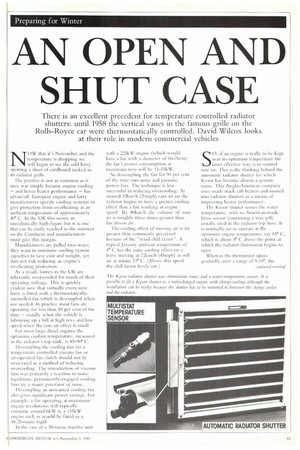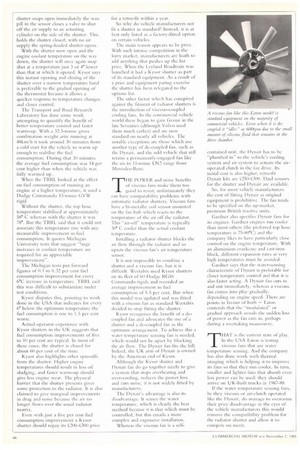AN OPEN AND SHUT CASE
Page 67

Page 68

If you've noticed an error in this article please click here to report it so we can fix it.
There is an excellent precedent for temperature controlled radiator shutters: until 1958 the vertical vanes in the famous grille on the Rolls-Royce car were thermostatically controlled. David Wilcox looks at their role in modern commercial vehicles
OW that it's November and the temperature is dropping we will begin to see the odd lorry sporting a sheet of cardboard tucked in its radiator grille.
The practice is not as common as it once was simply because engine cooling — and hence heater performance — has advanced. European engine and lorry manufacturers specify cooling systems to give protection from overheating at an ambient temperature of approximately 40° C. In the UK this seems an unrealistically high figure but it is one that can be easily reached in the summer on the Continent and manufacturers must give this margin.
Manufacturers are pulled two ways; they want to minimise cooling system capacities to save cost and weight, yet dare not risk reducing an engine's overheating protection.
As a result, lorries in the UK are inherently over-cooled for much of their operating mileags....1.his is quickly evident now that virtually every new lorry is fitted with a thermostaticallycontrolled fan which is de-coupled when not needed. In practice most fans are operating for less than 10 per cent or the time — usually when die vehicle is labouring up a hill at high revs and low speed when the ram air effect is small.
for most large diesel engines the optimum coolant temperature, measured in the radiator's top tank, is 85-90° C.
lk-coupling the cooling fan via a temperature controlled viscous fan or air-operated Ian clutch should not be over-rated as a method of reducing overcooling. The introduction of viscous fans was primarily a reaction to noise legislation; permanently-engaged cooling fans are a major generator of noise.
De-coiipling an unwanted cooling fan also gives significant power savings. For example, a Ian operating at maximum engine revolutions will typically consume around ()kW in a 115kW engine such as would be fitted in a 16.25-m1111e rigid.
In the case of a 38-tonne tractive unit with a 225k1X1 engine (which would have a fan with a diameter of (s6-76cm) the fan's power consumption at maximum revs will he 11-15kW.
So de-coupling the fan for 90 per cent of the time cuts noise and parasitic power loss. The technique is less successful in reducing overcooling. At around 32km/h (2i)riph) rain air on the radiator begins to have a greater cooling effect than a fan working at engine speed. By /km/h the volume of ram air is roughly three times greater than fan driven air.
The cooling effect of moving air is far greater than commonly perceived because of the "wind chill factor-. A typical January ambient temperature of 40 C has the same cooling effect on a lorry moving at 72kin/h (45mpli) as still air at minus 13° C. (Above this speed the chill factor levels out.) S0, if an engine is really to be kept near its optimum temperature the most effective way is to control rain air. This is the thinking behind the automatic radiator shutter for winch Kysor has become almost a generic name. This Anglo-American company once inade truck cab heaters tild moved into radiator shutters as a Illeat1S of improving heater performance.
'l he Kysor shutter senses the water temperature. with Us American-made brass sensor (containing a wax pill) usually sited in die radiator top hose. It is normally set to operate at the optimum engine temperature, say g5° C, which is about 5° C above the point at which the radiator thermostat begins to open.
Whereas the thermostat opens gradually over a range of 5-I 1°. the shutter snaps open immediately the wax pill in the sensor closes a valve to shut off the air supply to an actuating cylinder on the side of the shutter. This holds the shutter closed; with no air supply the spring-loaded shutter opens.
With the shutter now open and the engine coolant temperature on the way down, the shutter will once again snap shut at a temperature just 3 or 4° lower than that at which it opened. Kysor says this instant opening and closing of the shutter over a narrow temperature band is preferable to the gradual opening of the thermostat because it allows a quicker response to temperature changes and closer control.
The Transport and Road Research Laboratory has done sonic work attempting to quantity the benefit of better teniperature c•cmtrol and faster warm-up. With a 32.5-tonne gross combination weight attic running at 48km/h it took around 30 minutes from a cold start for the vehicle to warm up enough to stabilise the fuel consumption. During that 30 minutes the average fuel consumption was 14 per cent higher than when the vehicle was fully warmed up..
When the TRIM_ looked at the effect on fuel consumption or running an engine at a higher temperature, it used a Dodge Commando 13-tonne GVW rigid.
Without the shutter, the top hose temperature stabilised at approximately 58° C whereas with the shutter it was 78°. But the TRIZL. said that it could not associate this temperature rise with any measurable improvement in fiael consumption. It quotes Michigan University tests that suggest "large increases in coolant temperature are required for an appreciable improvement".
The Michigan tests put forward figures of 0.1 to 0.32 per cent fuel consumption improvement for every 6°C increase in temperature. TRRL said this was difficult to substantiate under test conditions.
Kysor disputes this, pointing to work done in the USA that indicates for every 6° below the optimum temperature the fuel consumption is one to 1.5 per cent Worse.
Actual operator experience with Kysor shutters in the UK suggests that fuel consumption improvements of live to 10 per cent are typical. In most of these cases, the shutter is closed for about (.4) per cent of the time.
Kysor also highlights other spin-offs from the shutter. I higher engine temperatures should result in less oil sludging, and fluster warm-up should give less engine wear. The physical barrier that the shutter presents gives some protection to the radiator. It is also claimed to give marginal improvements in drag and noise because the air no longer flows over the usual radiator matrix.
Even with just a five per cent fuel consumption improvement a Kysor shutter should repay its N:200-0(X) price for a retro-fit within a year.
So why do vehicle manufacturers not fit a shutter as standard? Instead, it is at best only listed as a factory-fitted option on certain vehicles.
The main reason appears to be price. With such intense competition in the lorry market, manufacturers arc loath to add anything that pushes up the list price. When the Leyland Roadtrain was launched it had a Kysor shutter as part of its standard equipment. As a result of a price and equipment paring exercise the shutter has been relegated to the options list.
The other fictor which has conspired against the fitment of radiator shutters is the introduction of viscous-coupled cooling Ems. In the commercial vehicle world these began to gain favour in the late Seventies (although Volvo used them much earlier) and are now standard on nearly all vehicles. The notable exceptions are those which use another type of de-coupled Fan, such as the Dvnair, and the odd vehicle that still retains a permanently-engaged fin like the six to II-tonne LN2 range From Mercedes-Benz.
THE POWER and noise benefits c.„ viscous fans make them too good to resist; unfortunately they can have comparability problems with automatic radiator shutters. Viscous fans have a hi-metallic coil sensor mounted on the fan Imb which reacts to the temperature of the air off the radiator. This "air-oft— temperature is typically 30° C cooler than the actual coolant temperature.
Installing a radiator shutter blocks the air flow through the radiator and so upsets the viscous tan's air temperature sensor.
It is not impossible to combine a shutter and a viscous fan, but it is difficult. Weetabix used Kysor shutters on its fleet of 601 Xidge 1G16 Commando rigids and recorded an average improvement in fuel consumption of 5.5 per cent. But when this model was updated and was fitted with a viscous fan as standard Weetabix decided to stop fitting the shutter.
Kysor recognises the benefit of a decoupled an and advocates the Use of a shutter and a de-coupled fan as the optimum arrangement. To achieve this a water temperature sensing fin is needed, which would not be upset by blocking the air flow. -ihe Dynair fan fits the bill. Indeed, the UK arm of Dynair is owned by the American end of Kysor.
Although the Kysor shutter and Dynair fan do go together nicely to give a system that stops overheating and over-cooling, reduces the power loss and cuts noise, it is not widely fitted by manufacturers.
The Dynair's advantage is also its disadvantage. It senses the water temperature, which is clearly the best method because it is that which must he controlled, but this entails a more complex and expensive installation.
Whereas the viscous fan is a sel1
contained unit, the Dynair has to be "plumbed into the vehicle's cooling system and air system to actuate the airoperated clutch in the fan drive. its initial cost is also higher: retro-Fit Dynair kits are 0.50-0110. Dual sensors for the shutter and Dynair are available.
So, for mostvehicle manuficturers the cost of fitting Dynair as original equipment is prohibitive. The fan tends to be specified on the up-market, premium British tractive units.
Gardner also specifies Dynair fans for its engines. Gardner engines run cooler than most others (the preferred top hose temperature is 75-80°C) and the company likes to have particularly close control on the engine temperature. With an aluminium crankcase and cast-iron block, different expansion rates at very high temperatures must be avoided, Gardner says that the water-sensing characteristic of Dynair is preferable (or closer temperature control ;Ind that it is also faster acting, A Dynair Fan cuts in and out immediately, whereas a viscous Fan comes into play gradually,
depending on engine speed. There are points in favour of both — Eaton contends that the -modulated" or gradual approach avoids the sudden loss of power as the fan cuts in. perhaps during a overtaking manoeuvre.
THAT is the current state of play. In the USA Eaton is testing viscous fans that use water temperature sensing,. And the company has also done work with thermal imaging which is helping it to improve its fans so that they run cooler. In turn, smaller and lighter fans that absorb even less power can be used; they should arrive on UK-built trucks in 1987-88.
If the water temperature sensing fans, be they viscous or air-clutch operated like the Dynair,c. I
o manage to overcome their price disadvantage in the eyes of the vehicle manithcturers this would remove the compatibility problem for the radiator shutter and allow it to compete on merit.












































































































